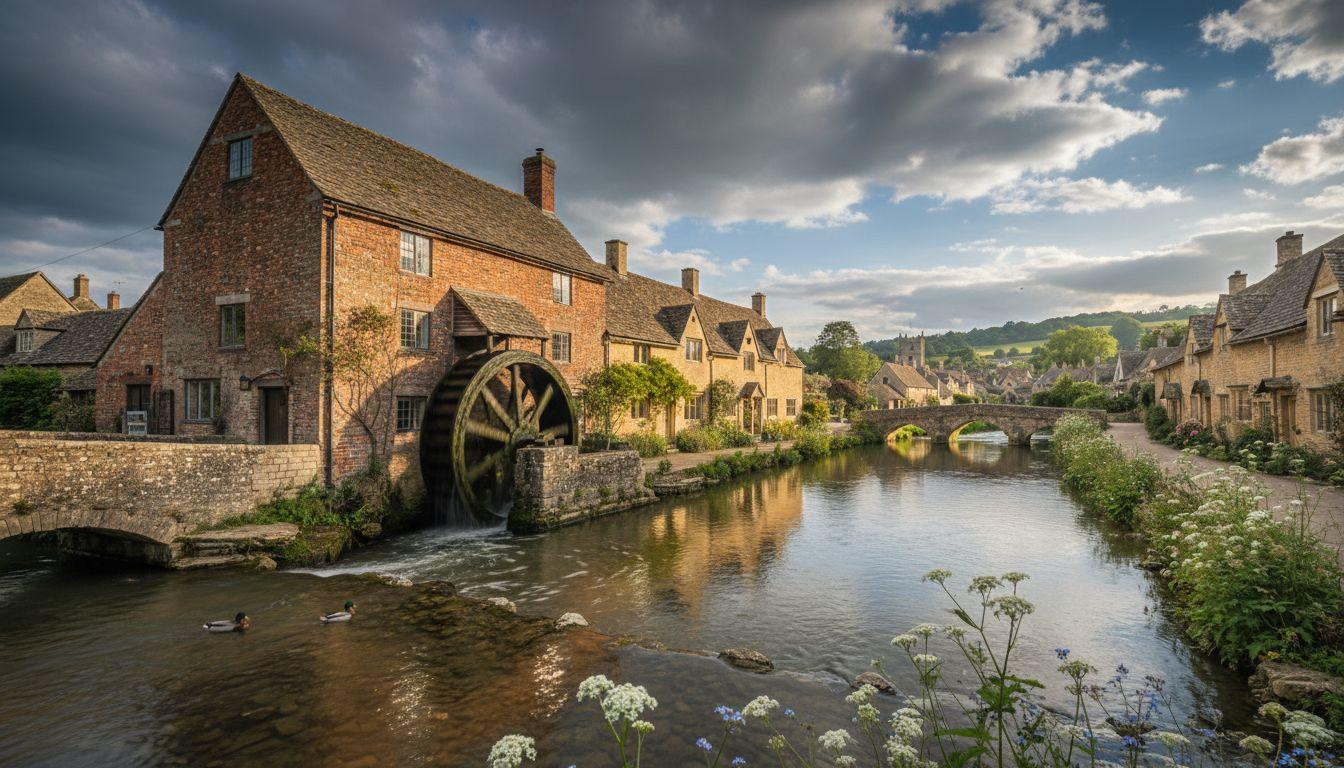At 3:00 PM on a Tuesday afternoon, when most tourists have abandoned the Cotswolds for tea shops and gift stores, Lower Slaughter reveals its true character. The Old Mill’s waterwheel turns slowly in the River Eye, creating perfect reflections that photographers dream about but rarely capture. This village of 200 residents sits 34 miles from Oxford, unchanged since 1906.
Here, afternoon light transforms honey-colored stone into something almost ethereal. The working waterwheel reflects in clear, shallow water while mallard ducks paddle beneath ancient footbridges. Unlike neighboring Bourton-on-the-Water with its 8,000 daily summer visitors, Lower Slaughter maintains an unhurried pace that feels genuinely medieval.
Where medieval England stands still
The River Eye flows through Lower Slaughter at walking speed, barely 10-13 feet wide at the mill. Its limestone bed creates mirror-like reflections perfect for capturing the 19th-century waterwheel. The current structure replaced mills dating to 1086, when Domesday Book scribes first recorded milling activity here.
Honey-colored Cotswold stone cottages line the riverbank, their mullioned windows catching afternoon sun. No building has been constructed since 1906, when preservation laws froze the village in architectural time. Bibury’s Arlington Row cottages 12 miles north draw larger crowds, but Lower Slaughter’s integrated mill and river setting creates more dynamic compositions.
Copse Hill Road, voted Britain’s most romantic street, connects stone footbridges with views of the working waterwheel. Wild roses bloom along stone walls from May through July, while meadowsweet and water forget-me-nots frame the riverbank through August.
The waterwheel moment that stops time
What the reflection reveals
The Old Mill’s undershot waterwheel turns continuously, powered by River Eye flow. Though currently under renovation, the exterior mechanism remains visible and operational. Clear water depth of 6-12 inches reveals smooth limestone stones beneath, creating perfect mirror conditions during calm afternoons.
Red brick mill walls contrast beautifully with honey stone cottages. The mill operated as a flour producer until 1958, when tourism gradually replaced agriculture as the village’s economic foundation. Steam chimney remnants speak to 19th-century efficiency improvements.
Why afternoon light changes everything
Golden hour occurs between 7:45 PM and 8:45 PM during August, when western light hits the mill’s facade directly. The waterwheel faces west, creating dramatic spoke shadows on moving water. Morning visits offer solitude, but afternoon sessions deliver the photographic magic that social media celebrates.
Stone bridges provide natural frames for mill shots. Two primary footbridges offer different angles, with the western bridge delivering optimal reflection compositions. European villages with similar preservation efforts rarely combine working historical features with such accessible photography opportunities.
Living history without performance
Walking the village circuit
The River Eye footpath connects Lower Slaughter to Upper Slaughter via a well-maintained 1-mile trail. The path begins past the Old Mill, following gentle water flow across fields and over stone footbridges. Walking time averages 25 minutes each direction through pastoral countryside.
Village circuit loops take 35-45 minutes, incorporating both riverbanks and Copse Hill Road. Grey wagtails and kingfishers occasionally appear near the mill, while mallard ducks provide reliable wildlife subjects. Peak District’s medieval churches 25 miles from Manchester offer similar historical atmospheres with broader hiking opportunities.
Authentic local experiences
The Old Mill coffee kiosk operates during current renovations, serving organic coffee while interior restoration continues. Pre-renovation cream teas cost approximately $10, with traditional scones, clotted cream, and local jam. The mill’s small gift shop features Cotswold stone crafts and handmade textiles from regional artisans.
No pubs exist within Lower Slaughter itself. The Slaughters Country Inn, 1.2 miles away in Upper Slaughter, serves traditional Gloucestershire specialties including Old Spot pork and local cheeses. Rooms start at $200 per night, as Lower Slaughter’s preservation rules prevent accommodation development.
The quiet they preserved
Building restrictions since 1906 mean Lower Slaughter feels authentically medieval rather than reconstructed. Bourton-on-the-Water, just 2 miles away, accommodates families with model villages and river activities. Lower Slaughter deliberately maintains adult-oriented tranquility.
Parking remains extremely limited, with only 15 spaces near the village center. European towns managing seasonal tourism face similar challenges balancing preservation with accessibility. Weekend arrivals after 11:00 AM rarely find village parking.
Instagram hashtag #LowerSlaughter shows 42,000 posts compared to #BourtonOnTheWater’s 315,000, indicating relative undiscovery. Local tourism boards estimate 200-300 weekday visitors versus 600-800 on weekends, making timing crucial for peaceful experiences.
Your questions about Lower Slaughter answered
When should I visit Lower Slaughter?
Late spring through early autumn (May-September) offers the best weather and wildflower displays. Weekday mornings before 10:00 AM provide the most solitude. Golden hour photography works best from 7:45 PM-8:45 PM during summer months, when western light illuminates the mill facade directly.
How do I get there from Oxford?
Drive 45-60 minutes via A40 and B4425, covering 32 miles through Cotswold countryside. Moreton-in-Marsh train station sits 11 miles away, with taxi service costing $30-40. Stagecoach bus route S1 runs hourly, stopping 0.5 miles from the village center.
How does it compare to other Cotswold villages?
Lower Slaughter receives significantly fewer visitors than Bourton-on-the-Water’s 8,000-10,000 daily summer guests or Bibury’s 5,000. The working mill and river reflections create unique photographic opportunities absent in most preserved villages. Authenticity levels remain higher due to stricter development controls.
The waterwheel completes another slow revolution, casting moving shadows across limestone water. Afternoon light fades toward evening, but the reflection holds steady. This moment, repeated daily for over 900 years, continues regardless of cameras or crowds.
